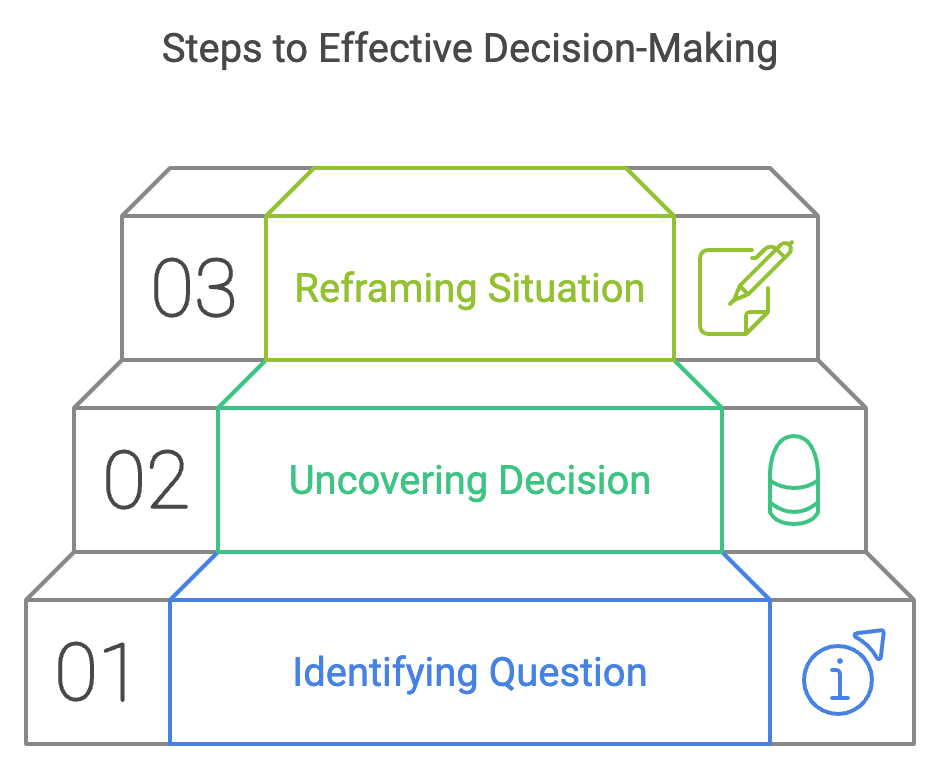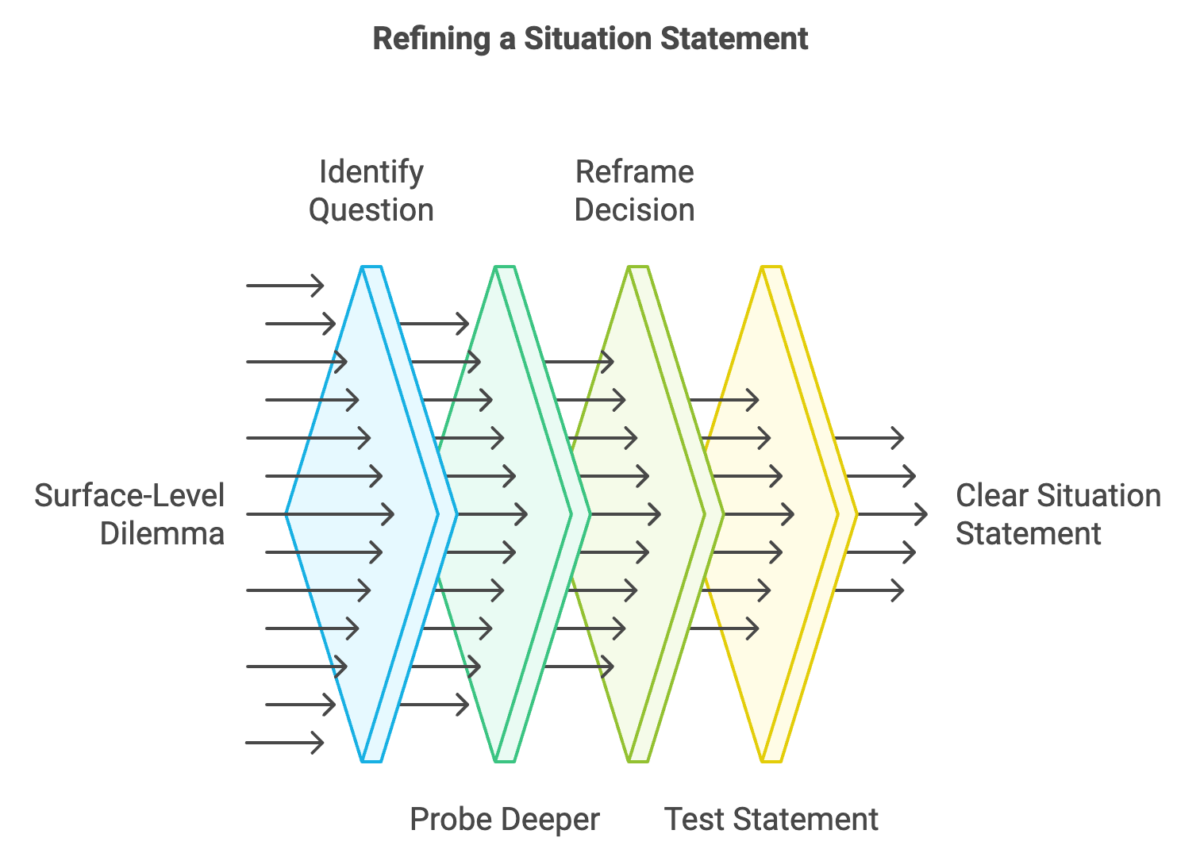Understanding the True Decision You Need to Make
Introduction: Why Situational Clarity Matters
In navigating life’s challenges, it is easy to become distracted by surface-level questions that obscure the deeper, more significant choices at hand. Situational clarity is the ability to see past this noise and articulate the real decision you are grappling with. At its core lies the concept of a situation statement, a clear and concise definition of what you must resolve to move forward meaningfully.
Without this clarity, decisions become mired in confusion, driven by emotion or external pressure rather than true understanding. Situational clarity empowers you to ask better questions, leading to purposeful, values-driven actions.
What Is a Situation Statement?
A situation statement is the distilled essence of a decision. It refines the surface-level dilemma into its most meaningful form, focusing on the core conflict rather than peripheral concerns. Crafting a situation statement involves:
- Identifying the Perceived Question: What do you initially believe is the issue?
- Uncovering the Underlying Decision: What deeper concerns or priorities are influencing your question?
- Reframing the Situation: How can you rewrite the question to reflect the core choice in a meaningful way?

For example:
- Surface Question: “Should I homeschool my child?”
- Underlying Question: “Am I confident enough to take full responsibility for my child’s education, even if it means diverging from societal norms?”
- Secondary Questions:
- “Will my child have enough opportunities for socialisation and meaningful relationships?”
- “Will homeschooling make my child happy, or will they feel isolated?”
- Situation Statement: “I need to decide whether homeschooling better supports my child’s well-being, growth, and happiness, while balancing my ability to meet these demands effectively.”
Why Situational Clarity Is Essential
Situational clarity ensures you address the real problem rather than its symptoms. Decisions made without clarity often lead to misaligned outcomes, wasted energy, or a sense of dissatisfaction. By articulating a clear situation statement, you ensure your actions address the root of the issue and align with your long-term goals.
Recognising multiple underlying questions is also critical because a single decision often carries a web of interconnected concerns. Acknowledging these allows you to develop comprehensive, thoughtful solutions that address the full complexity of your situation.
For instance, in the homeschooling example, the surface question might appear simple, but underlying it could be concerns such as:
- “Am I equipped to handle the academic and emotional challenges of homeschooling?”
- “Will my child have enough social interactions and friendships?”
- “Will my child feel fulfilled and happy with this arrangement?”
Acknowledging these secondary questions allows for a deeper and more balanced approach to decision-making. Ignoring these concerns can undermine your decision-making process, leading to unresolved anxiety.
Examples of Reframing Decisions Through Situational Clarity
1. “Should I leave my husband?”
- Perceived Decision: To stay or leave.
- Real Decision: “Am I prepared to advocate for the respect and partnership I deserve, even if that means risking the stability of my marriage?”
- Deeper Dive: The decision might not just be about leaving but also about assessing your self-esteem and boundaries. Questions such as “Do I truly believe I am worthy of respect?” or “Have I exhausted all avenues to improve communication?” might arise.
- Situation Statement: “I need to decide whether prioritising my emotional health and dignity matters more than my fear of disrupting my family’s stability.”
2. “Should I homeschool my child?”
- Perceived Decision: Whether to choose traditional schooling or homeschooling.
- Real Decision: “Am I confident in my ability to provide an enriching education that aligns with my values and supports my child’s needs?”
- Deeper Dive:
- “Can I create opportunities for my child to socialise and build friendships?”
- “Will I have the patience, time, and resources to balance my responsibilities?”
- “Am I responding to societal expectations or my child’s actual needs?”
- Situation Statement: “I need to decide whether homeschooling better supports my child’s growth and happiness while ensuring I have the capacity to meet the demands of this role.”
3. “Which life path should I take?”
- Perceived Decision: Choosing between multiple career or personal paths.
- Real Decision: “Do I value financial security and stability more, or do I prioritise passion and long-term fulfilment?”
- Deeper Dive: Questions such as “Am I afraid of failure, or is it a valid concern?” and “What kind of legacy or impact do I want my life to reflect?” might arise.
- Situation Statement: “I need to decide whether pursuing stability or embracing uncertainty in favour of purpose will better align with my vision for my life.”
4. “Should I accept this promotion?”
- Perceived Decision: To accept or decline.
- Real Decision: “Am I willing to prioritise career growth over my current work-life balance?”
- Deeper Dive: This decision might also involve examining questions like:
- “What are the long-term implications of this role on my family or personal well-being?”
- “Am I seeking validation through external achievements?”
- Situation Statement: “I need to decide whether the benefits of professional growth outweigh the potential sacrifices to my current lifestyle.”
5. “Should I move to a new city?”
- Perceived Decision: To stay or relocate.
- Real Decision: “Am I ready to leave my comfort zone and embrace the uncertainty of a new environment for the sake of personal or professional development?”
- Deeper Dive:
- “Will I regret not taking this opportunity?”
- “What support systems can I create in a new location?”
- “Is this move driven by a desire for growth or an escape from my current problems?”
- Situation Statement: “I need to decide whether the potential for growth and opportunity outweighs the comfort and security of staying where I am.”
6. “Should I forgive someone who hurt me?”
- Perceived Decision: To forgive or hold onto resentment.
- Real Decision: “Do I prioritise my inner peace over the need for justice or validation of my pain?”
- Deeper Dive:
- “Am I forgiving because I truly feel ready to release the burden, or because I feel pressured by societal or relational expectations?”
- “Does forgiveness mean I condone the behaviour, or can it be an act of self-liberation?”
- “What boundaries do I need to establish to protect myself if I forgive this person?”
- “How does holding onto resentment impact my emotional and mental well-being?”
- Situation Statement: “I need to decide if letting go of resentment serves my emotional and mental well-being, even if the person who hurt me never apologises or faces consequences.”
7. “Should I confront my friend about their behaviour?”
- Perceived Decision: To confront or remain silent.
- Real Decision: “Am I prepared to risk discomfort and potential conflict for the sake of authenticity and preserving a meaningful relationship?”
- Deeper Dive:
- “What outcome am I hoping for by addressing this behaviour—understanding, change, or closure?”
- “Am I reacting out of hurt or anger, or have I reflected on the best way to communicate constructively?”
- “If the conversation doesn’t go as planned, am I prepared to accept the consequences, such as tension or a change in the relationship?”
- “What would remaining silent cost me in terms of trust, connection, or self-respect?”
- Situation Statement: “I need to decide whether being honest about my feelings and seeking resolution outweighs my fear of tension and potential fallout in the relationship.”
Why Recognising Multiple Underlying Questions Is Important
- Comprehensive Clarity: By identifying all the underlying questions, you can address each one directly, ensuring that your final decision considers the full scope of your concerns.
- Emotion Management: Many secondary questions are driven by fear or doubt. Acknowledging them helps you manage these emotions, allowing you to focus on the rational core of the decision.
- Better Solutions: Understanding the full complexity of your dilemma enables you to explore creative solutions that address multiple concerns simultaneously.
How to Address Multiple Underlying Questions
- List All Concerns: Write down every fear, hope, or question that arises when thinking about your decision. For homeschooling, this might include concerns about academics, socialisation, happiness, or personal capacity.
- Group by Themes: Categorise these concerns into broader themes, such as emotional well-being, practical feasibility, and long-term outcomes.
- Prioritise Core Values: Determine which concerns are most closely tied to your values. For example, is your primary focus your child’s happiness, their academic success, or alignment with family values?
- Address Each Question Separately: For each underlying question, consider whether there is evidence to support or alleviate your concerns. For example:
- For socialisation: Research local homeschooling groups or co-ops where your child can interact with peers.
- For happiness: Reflect on your child’s personality and whether homeschooling would suit their preferences and learning style.
The Power of Clarity
The decisions we face are rarely as straightforward as they appear. The ability to recognise and articulate the true question at hand is both an intellectual and emotional discipline. By crafting clear situation statements, you create a foundation for decisions that are aligned with your values and free from unnecessary distraction.
In this practice lies empowerment: the ability to face life’s challenges with focus, integrity, and purpose. A well-written situation statement does not just clarify the decision—it reveals the person you aspire to become.
How to Write a Situation Statement
Creating a situation statement is both reflective and practical. Follow these steps:
-
- Identify the Perceived Question: Write down the surface-level dilemma.
- Probe for Deeper Questions: Ask why this decision matters and what fears or desires influence it.
- Reframe the Decision: Articulate the underlying choice in a way that aligns with your values.
- Test the Statement: Ensure it captures the real conflict without distraction.

Generic Situation Statement Templates
If you find yourself stuck, here are some generic templates to guide you:
- Generic Situation Statement Template
“I need to decide whether [primary option] better supports my [core value or goal], considering [secondary concerns or fears].” - Personal Growth-Oriented Template
“The real decision I am facing is whether I am willing to [action or mindset] in order to achieve [desired outcome], even if that means [potential sacrifice or fear].” - Value-Driven Template
“My decision is about choosing between [option one] and [option two], based on what I value more: [value one] or [value two].” - Exploration and Fear Management Template
“I am trying to determine if [primary action or decision] aligns with [desired outcome], or if my hesitation is rooted in [specific fear or limiting belief].” - Short and Reflective Template
“The decision I face is whether [action] aligns with my [core value], even if [potential consequence].”
The Power of Clarity in Life’s Decisions
Decisions shape the trajectory of our lives, but clarity is the compass that ensures we travel in the right direction. Crafting a situation statement is more than just a practical exercise—it’s a profound act of self-awareness. It allows you to distil the noise of external pressures, emotions, and assumptions, revealing the core of what truly matters. When you gain this clarity, you create the foundation for authentic, value-aligned choices.
However, clarity is not always easy to achieve. You may feel overwhelmed by the complexity of your situation or struggle to identify the underlying questions driving your dilemma. Even with a clear situation statement, knowing what to do next can feel daunting.
Seek Support if You’re Stuck
If you find yourself unable to create a situation statement or feel unsure of the next steps once you have one, it’s time to reach out for guidance. A decision coach can help you untangle the layers of your dilemma, uncover your values, and empower you to move forward with confidence and purpose.
Don’t let indecision hold you back from the life you deserve. Take the first step by seeking clarity and support—because every decision you make is a vote for the person you are becoming.
-
Solve It In 60From confusion to clarity in just one structured call
-
£175
-
> 10 Years Coaching Experience
-
Multi Decision
-
60-Minute Call Duration
-
Situation Statement
-
Follow Up Email
-
Suggested Answer
-
Goal GettersStay on track for long-term success
-
£297/month
-
> 6 Years Coaching Experience
-
1-Hour Coaching Call Every Month
-
60 Days Coaching Duration
-
3 Touchpoints Per Week
-
Online Coaching Feed
-
Free Online Course & Metrics
-
Quick DiveMove forward with purpose
-
From £80
-
7 days of online coaching feed
-
20 minutes of live calls included
-
Up to 5 touchpoints
-
£80 with Associate Coach
-
£125 with Senior Coach
-
£215 with Head Coach
-
Deep DiveMaster the art of getting things done
-
From £125
-
14 days of online coaching feed
-
30 minutes of live calls included
-
Up to 10 touchpoints
-
£125 with Associate Coach
-
£170 with Senior Coach
-
£260 with Head Coach
















